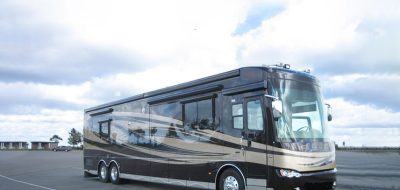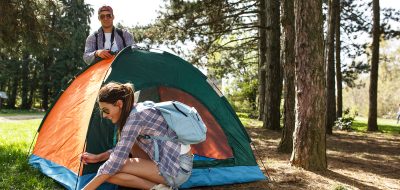Let me ask you a question. If you were planning a 500 mile trip in your family automobile would you check the vehicle out before leaving on the trip? I mean would you check the fluid levels, tires, lights and windshield wipers to make sure everything was operating properly before attempting to travel 500 miles in the vehicle. I hope your answer was yes. If your answer was no there is a possibility you will be one of those vehicles you see stranded along the side of the road, broken down 200 miles away from home or your destination.
If it makes sense to check your automobile out before a long trip, it would make sense to check your RV out before a trip too. This is even truer if the RV has been sitting for several months, or more, since your last trip.
Okay, we established that it is a good idea to make a few simple checks before heading out on the next camping trip of the year, but what exactly should you check. Regardless of the type of RV you have here are a few things you should check.
Let’s start with the outside of the RV.
__ Check and adjust the air pressure in all tires. Always check the tires when they are cold, before traveling more than one mile.
__ Check the lug nuts on the wheels. Discoloration and stains around lug nuts indicate they may be loose.
__ Make sure all items in the storage compartments are secure. Lock all outside compartments.
__ Check the bike rack and bikes for secure mounting if applicable.
__ Make sure the power cord, water hose, and sewer hose are disconnected and properly stored.
__ Make sure all slide outs are in the travel position and any travel locks are securely in place.
__ Make sure the TV antenna and / or satellite are down and stowed in the proper position for traveling.
__ Check the awning. Make sure that it is securely stored and all travel locks and knobs are tight and locked.
__ Raise all stabilizer jacks or hydraulic leveling jacks.
__ Look under the RV for any indications of leaks (motorized) or anything out of the ordinary. Have any leaks checked out and repaired before leaving on your trip.
__ Stow or retract the steps.
__ Fill the fresh water holding tank with enough potable water to get to your destination.
__ Check and secure the cap on the sewer outlet.
__ Turn all LP gas appliances off and turn the gas supply off at the tank or bottles.
__ Double check all hitch work on towable RV’s and on vehicles being towed behind motor homes.
__ Check all fluid levels for motorized RV’s and tow vehicles.
__ Remove and store wheel chocks and any type of leveling blocks.
__ Check all running lights, turn signals, brake lights and headlights on the RV and tow vehicle.
__ Check for an up to date inspection or emission sticker and license plates.
__ Check the operation and condition of the windshield wiper. Replace wiper blades as required.
__ Check all fire extinguishers for a full charge and serviceable condition.
__ Check trailer brakes for proper operation.
__ Make one last walk around the outside of the RV and check for anything you may have overlooked.
Don’t forget the inside of your RV:
__ Walk through the entire RV and secure all loose items that could move, fall or get damaged while traveling.
__Turn off all appliances gas & electric. Turn off all pilot lights.
__ Close all roof vents
__ Close all doors, drawers and cabinets
__ Check for anything in the refrigerator that could spill. Lock the refrigerator and freezer doors.
__ Turn off the 12-volt water pump.
__ Close the range top cover.
__ Turn off all 12-volt lights and accessories that could drain the auxiliary battery. Don’t forget the TV antenna booster.
__ Close the windows and secure blinds.
__ Secure any large items such as TVs that might move or fall while traveling.
__ All weight in the RV should be distributed evenly. Adjust your mirrors and seat and hit the road.
This checklist is not all-inclusive, but it’s a good start. You can add to this list and tailor it to your specific type of RV. The most important thing to remember is to use this checklist every time you use your RV. It’s easy to forget something without a reminder. I always do one last walk around of the RV just before pulling out. You’ll be amazed at what you may have missed the first time around.
This checklist is an excerpt from my Checklists for RVers E-book
Happy Camping,
Mark Polk






eric
G.M. – thank you for the guidance! We newbies appreciate it! 😀
g.m.
Oh may we also suggest that you have the vehicle drive line joints checked… towing puts a larger strain on them and they are not going to last as long…
Also hoses and belts… should be changed at a interval… nothing like blowing a hose along side the road.. and having to wait for AAA to tow you back.. Not only will you need a hose but may have to have some mechanical work done if it overheated and burnt some of the engine parts.. We had a heater hose blow right off the fitting on our truck.. they use this little spring clamp.. cheap… when done not only did the hose have to be replaced.. (by the way the dealer use the same clamp again… go figure..:).) but it also cracked one head…. ouch.. that hurt the manufactures profits… lucky it was still under warrentee… but we had to wait a couple of days for it to be fixed… and that cut into our travel schedule…
g.m.
Wheel bearings and tires that sit for a while can become problematic.
Wheel bearings should be checked and/or inspected/greased at least every 5000 miles… what happens is that the bearings can pit from sitting and once it starts it never quits until they are replaced. If you run them and they are bad…they may get hot and noisy causing the wheel to drag and increasing the tire wear and your gas mileage decreases.
Rain water on the roadway is the major problem for them… they the bearings … get warm running.. then cool when you set.. and condensation gets sucked into the hub as they breath. Water and steel rust.
While your at it and have the wheel bearings off and getting re-greased.. one might want to also take a look at the elect or hyd brakes on the vehicle. Again that plate that the magnet slides on if rusty from sitting my want to be cleaned off before it can add increased wear to the electromagnet which works the brake shoes… If allowed to be rusty.. along with the brake drum… one is in for a exciting time when one applies the brakes the first time till the rust gets cut off… the most common event is when the rust increases the drag and cause the tire to lock up and “burn rubber” stopping. (needless to say this is not what one wants… where the rubber meets and stays on the road… not good)
Now when one side does lock up and the other doesn’t… you get differential brakeing… and this imbalance could cause a accident or damage parts. We know of several airstream owners who had to replace axels due to this problem… of course your expecting the trailer or RV brakes to stop you too… and when they don’t.. it gets real conversational with the other half as to why you are out in the middle of the intersection …instead of stopping behind the crosswalk…at that red light… due to the brakes not working right… Yet after a few uses.. they change and suddenly become different… it is that “different” that gets real exciting and memorable… as to what one can expect… normality…
Tires today are pretty good about ageing.. but , the rubber if exposed to the sun will get hard and not as flexable… this can lead to tire failure out on the road as it flexes in motion. A good tire shop can poke a pin into the rubber and tell you if its still good to go… Tires are a lot cheaper still than buying a new coach… after they blow out… so they become cheap insurance… if nothing else…. always have good tires for cheap insurance on the coach…
Another check is to have the tires spun and balanced… after they have been run for a few miles.. (burning rubber off the bottom if the brakes goof up). Let them “run in” and get round again… otherwise you get a flat spot on the bottom from sitting and the balance will be way out of line… (when we tow ours.. after setting even overnight… we always keep the speed down for the first couple of miles so the tires can get round again and not shake, rattle and roll… everything in the coach loose) Nothing like opening the door and seeing everything displaced inside… from the tire flats bouncing… if you do.. may I suggest you close the door quickly again… and disappear…go exploring, fishing, whatever… for several hours while the other half discovers what you did… and is left to streighten it up… your ears are going to burn .. no fooling…
this is just some of the things they are suggesting you should check when they mention the axle and wheels.. Before every seasion or first movement one should have “maintenance” done to insure a happy trouble free trip…
RV on…
eric
Okay, this is a good checklist… but it brings to mind a question I’ve had. recently, I was reviewing the manual for my travel trailer. One of the checks recommended for “prior to every trip” to add to the checklist is to check the axle and wheels.
Anyone have any ideas on how to do this? What I should look for? I’m pretty dumb when it comes to mechanical stuff… I have a hard time differentiating from an axle and a toilet. Okay, not really, but you get the idea.